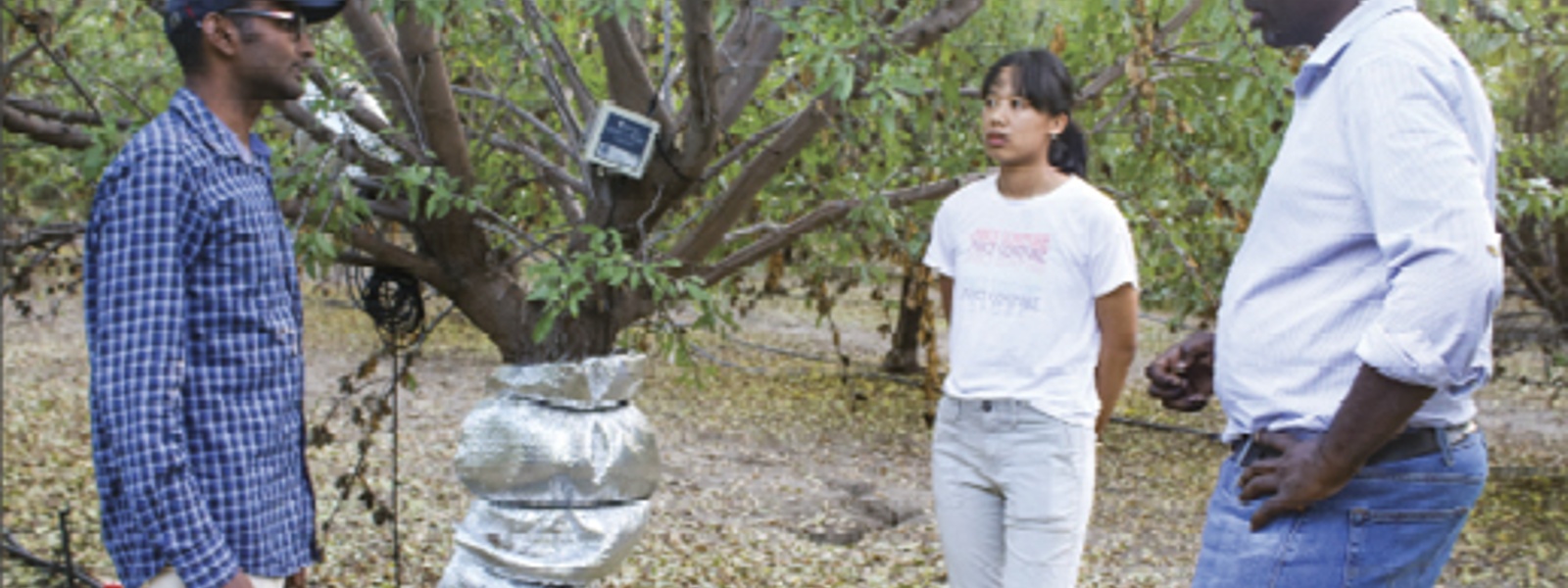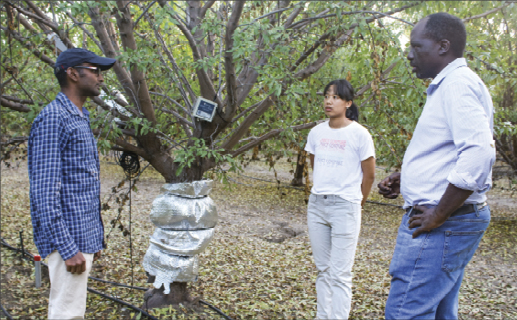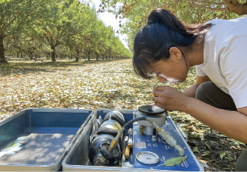New sensors could be 'game changer'





By Ching Lee
With water becoming a more costly and precious resource for farmers, new technology that allows farmers to detect how thirsty their trees are can now help them make better irrigation decisions—and get greater yields.
A variety of sensors have been on the market for years to measure soil moisture. But the holy grail of precision irrigation is measuring the tree’s stem water potential, or water status. This refers to the amount of energy a plant uses to draw water from the soil, said Isaya Kisekka, associate professor of hydrology and irrigation at the University of California, Davis.
Because of its accuracy and reliability, the pressure chamber, or pressure bomb, remains the “scientific benchmark” for measuring stem water potential, Kisekka said. It’s been around for decades, but the tool is not widely used because it tends to be “very laborious,” he said, requiring time in the field during the hottest part of the day to take samples and measurements.
“That’s why universities and research companies have worked for years to develop a more automated way to measure stem water potential,” Kisekka said.
He and his research team have been testing two sensors that made their commercial market debut during the past two to three years. One was developed by Davis-based FloraPulse, and the other comes from Saturas, an Israeli company with a North American subsidiary in Rancho Cordova near Sacramento.
Both work by embedding sensors inside the woody tissue of a tree or vine. FloraPulse uses a micro-tensiometer to measure stem water potential, while Saturas uses an osmometer. The sensors are wired to data loggers that upload measurements to the cloud, where the information can be retrieved on a computer, smartphone or other mobile device.
Kisekka and his team have been evaluating the sensors in different commercial orchards, mostly almonds, as part of a four-year study funded by the Almond Board of California. The project is in its third year. They’ve been taking weekly measurements and then comparing them to readings from the pressure chamber.
While findings are preliminary, Kisekka said the sensors have the potential to be “a game changer,” as they can directly measure stem water potential with an accuracy comparable to the pressure chamber.
“These sensors really have the potential to replace the old-school pressure bomb,” he said.
There are some differences between the two products. For example, Saturas’ osmometer is bulkier, so it’s typically installed on the tree trunk, whereas FloraPulse can be placed on a branch or trunk. Saturas provides daily water-status updates, while FloraPulse gives numbers almost every hour. Based on his field trials, Kisekka said Saturas sensors require calibration at installation to work accurately; FloraPulse doesn’t need it.
Both sensors don’t work well on walnut trees, which produce a fluid that interferes with the sensor, resulting in inaccurate readings.
Saturas says its technology can increase farmer income by 5% to 30% through higher yields, better fruit quality and by saving on inputs. It says its sensors can save farmers 10% to 20% on water.
Citing a customer case study, FloraPulse says use of its sensors increased the grower’s revenue by $734 per acre. CEO Michael Santiago said that number was derived from the grower’s increased production of about 15%. The company also says the grower eliminated fruit-drop losses from 30% to less than 1% and was able to decrease irrigation by 40%.
Kisekka said his research so far has not been able to quantify how much water growers may save with the new sensors, but he noted there could be additional cost savings in labor and energy to pump water.
“The biggest impact really is increase in yield and quality,” Santiago said. “We’ve seen that healthier trees produce more crop. They have less issues with disease. That’s really the main selling point.”
FloraPulse sells its sensors with a yearly subscription service. The sensors are replaced every year as part of the service. Santiago said growers may buy just the sensors for a one-time fee, but they would need to have their own telemetry support.
Yariv Erez, head of Saturas’ North America operations, said cost of its service depends on farm size, crop type and location. He said the return on investment for various crops is as quick as 30 to 60 days. Growers who are familiar with stem water potential and who are early adopters are “happy with the results,” he added.
Since FloraPulse sold its first sensor at the end of 2019, Santiago said the company has “made very limited sales”—mostly to scientists and to “advanced growers that have a better sense of what to do with the data.” But he said the company is now broadening its market, targeting growers with at least 1,000 acres.
Tehama County farmer Michael Vasey, who has been using FloraPulse on his prunes for three years, currently pays $1,500 a year per sensor, which he said is “pretty expensive.” Still, he said he finds enough value in it that he feels it’s worth paying for.
“You get real-time feedback on how stressed the orchard is, and you’re able to make finer-tune adjustments to your water, so I think there’s water saving,” he said, though he couldn’t quantify it.
Whereas he used to add irrigation an hour at a time, he said he can now add water at much shorter durations, such as 15 minutes, and then get real-time feedback on how thirsty the tree is.
Water expenses are one of the highest production costs for Rod Chamberlain, a Riverside County mango farmer. Before trying the FloraPulse sensors, he was using soil moisture probes, which told him the water-holding capacity of his soil, but not how his trees were feeling. With the new sensor—which he’s been using going on three years—he can access information on how his trees are doing directly from his phone. He said the yearly $1,500-per-unit cost is “right in line with all the other probes.” Though he hasn’t calculated his total cost savings, he estimated he has slashed his water usage at least 25%.
“It’s really been a benefit,” he said of the sensor. “I think it’s going to be the future.”
Yolo County almond grower Jasleen Gulati has tried the Saturas and FloraPulse sensors. She now uses a manual soil moisture probe along with the FloraPulse sensor, which she said she found to be easier to use and more accurate than Saturas. Even with these tools, she said, deciding how long to irrigate involves a certain amount of guesswork.
“It’s not an exact science,” she said. “That’s just a judgment call.”
Kisekka agreed that the new sensors cannot tell growers how much water to apply. In precision irrigation, he said, growers need to know when to initiate irrigation, how much to apply and where, as conditions are not the same everywhere. Therefore, growers should use additional tools such as soil moisture probes and weather data “to really dial in your irrigation,” he added.
“That’s why irrigation is a simple but complicated science at the same time,” he said.
(Ching Lee is an assistant editor of Ag Alert. She may be contacted at clee@cfbf.com.)




